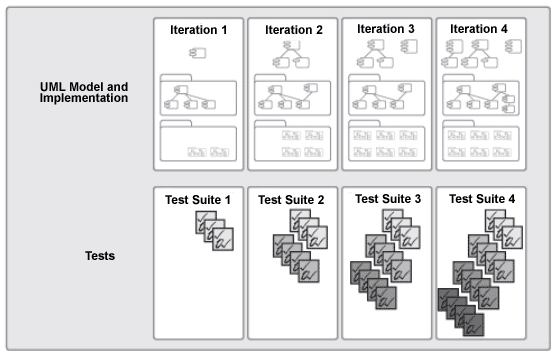| Concept: Focus Continuously On Quality |
 |
|
DiscussionImproving quality is not simply "meeting requirements," or producing a product that meets user needs and expectations. Rather, quality also includes identifying the measures and criteria that demonstrate its achievement, as well as the implementation of a process to ensure that the product has achieved the desired degree of quality, and that this can be repeated and managed. Ensuring high quality requires more than the participation of the testing team; it requires that the entire team owns quality. It involves all team members and all parts of the lifecycle:
When we experience a quality issue, every team member should be willing to chip in to address the issue. One of the major benefits of Iterative Development is that it enables a test early and continuously approach, as illustrated below. By the time we reach the end of a project, and since the most important capabilities are implemented early on, the most essential software may will have been up and running for months, and it is therefore likely it will have been tested for months. It is no surprise that most projects adopting iterative development claim that an increase in quality is a primary tangible result of the improved process.
Testing Is Initiated Early and Expanded Upon in Each Iteration As we incrementally build our application, we should also incrementally build test automation to detect defects early, while minimizing up-front investments. As we design our system, we consider how it should be tested. Making the right design decisions can greatly improve our ability to automate testing. We may also be able to generate test code directly from the design models. This saves time, provides incentives for early testing, and increases the quality of testing by minimizing the number of bugs in the test software. Automated testing has been a key area of focus for, among others, the agile community, where the aim is to automate testing of all code, and where tests are written before the code is written (test-first design.) |
© Copyright IBM Corp. 1987, 2006. All Rights Reserved. |
